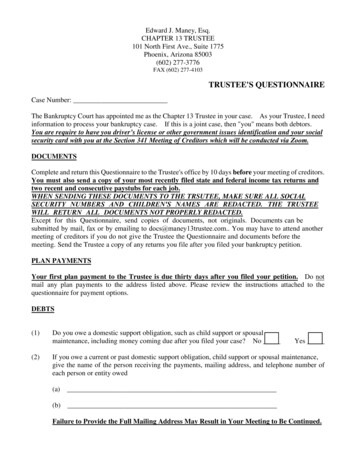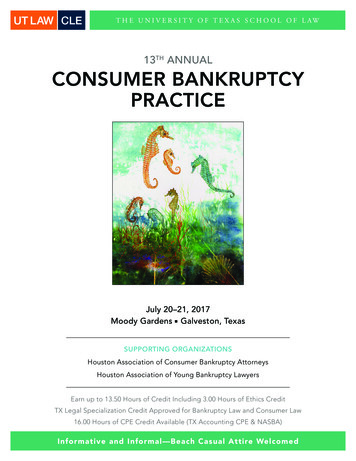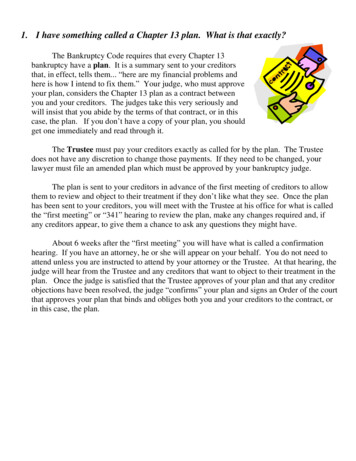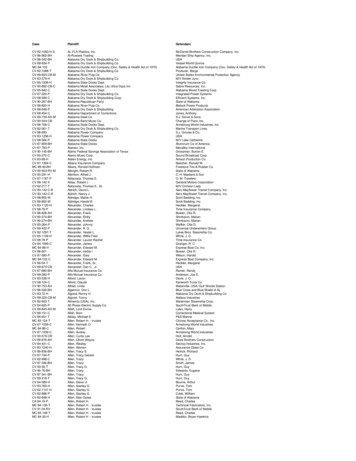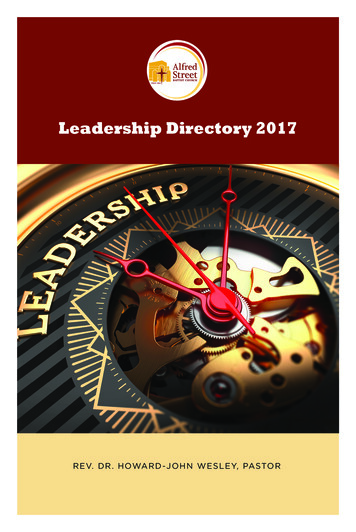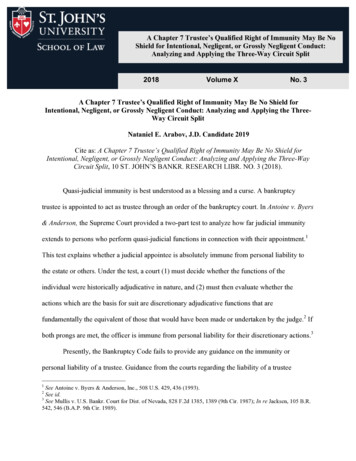
Transcription
A Chapter 7 Trustee’s Qualified Right of Immunity May Be NoShield for Intentional, Negligent, or Grossly Negligent Conduct:Analyzing and Applying the Three-Way Circuit Split2018Volume XNo. 3A Chapter 7 Trustee’s Qualified Right of Immunity May Be No Shield forIntentional, Negligent, or Grossly Negligent Conduct: Analyzing and Applying the ThreeWay Circuit SplitNataniel E. Arabov, J.D. Candidate 2019Cite as: A Chapter 7 Trustee’s Qualified Right of Immunity May Be No Shield forIntentional, Negligent, or Grossly Negligent Conduct: Analyzing and Applying the Three-WayCircuit Split, 10 ST. JOHN’S BANKR. RESEARCH LIBR. NO. 3 (2018).Quasi-judicial immunity is best understood as a blessing and a curse. A bankruptcytrustee is appointed to act as trustee through an order of the bankruptcy court. In Antoine v. Byers& Anderson, the Supreme Court provided a two-part test to analyze how far judicial immunityextends to persons who perform quasi-judicial functions in connection with their appointment.1This test explains whether a judicial appointee is absolutely immune from personal liability tothe estate or others. Under the test, a court (1) must decide whether the functions of theindividual were historically adjudicative in nature, and (2) must then evaluate whether theactions which are the basis for suit are discretionary adjudicative functions that arefundamentally the equivalent of those that would have been made or undertaken by the judge.2 Ifboth prongs are met, the officer is immune from personal liability for their discretionary actions.3Presently, the Bankruptcy Code fails to provide any guidance on the immunity orpersonal liability of a trustee. Guidance from the courts regarding the liability of a trustee1See Antoine v. Byers & Anderson, Inc., 508 U.S. 429, 436 (1993).See id.3See Mullis v. U.S. Bankr. Court for Dist. of Nevada, 828 F.2d 1385, 1389 (9th Cir. 1987); In re Jacksen, 105 B.R.542, 546 (B.A.P. 9th Cir. 1989).2
remains inconsistent. Currently, there are three viewpoints on this issue imposing liability for (1)intentional breach of a trustee’s fiduciary duties, (2) negligent breach of a trustee’s fiduciaryduties, and (3) grossly negligent breach of a trustee’s fiduciary duties. Accordingly, this Articlewill explain the doctrine of quasi-judicial immunity and will analyze a Chapter 7 trustee’spotential personal liability to suit, by application of the various standards used by the federalappellate courts to permit such liability.Part I of this Article will briefly discuss the roles and responsibilities of the bankruptcytrustee. These roles provide the guidelines of the expectation of a trustee and will help examine atrustee’s immunity or personal liability. Part II of this Article will address the doctrine of quasijudicial immunity as a defense to a personal liability claim. Part III will analyze the threedifferent standards bankruptcy courts now use to decide whether to permit personal liability ontrustees.I.The Role of the Chapter 7 Bankruptcy TrusteeA bankruptcy trustee plays a vital role in a chapter 7 bankruptcy case. Section 323 of theBankruptcy Code defines a trustee’s role as the “representative of the estate.”4 The trustee hastwo main obligations: (1) “fiduciary” obligations owed to the “bankruptcy court and the partiesin cases in which the trustee serves,” and (2) “institutional” obligations, owed “to the bankruptcyprocess itself.”5 Section 704 of the Bankruptcy Code provides the “institutional obligations” thechapter 7 trustee owes to the debtor and creditor, both of whom are the “beneficiaries” of theestate.6 Pursuant to Section 704 of the Bankruptcy Code, all trustees must be accountable for theproperty they receive and manage that property, must examine statements of claim filed in their411 U.S.C. § 323.See Steven W. Rhodes, The Fiduciary and Institutional Obligations of a Chapter 7 Bankruptcy Trustee, 80 AM.BANKR. L.J. 147, 147–48 (2006).6See In re Heinsohn, 231 B.R. 48, 65 (Bankr. E.D. Tenn. 1999).5AmericanBankruptcyInstituteLawReview 11439
cases and object to a claim that is improper, must furnish information concerning the estates andtheir administration to parties in interest, and must make and file reports with the court and theUnited States trustee.7 Trustees also conduct meetings where testimony is given and resolve therights of parties with respect to estate property. Additionally, they are charged with the importanttask of collecting and reducing to money property of the debtor’s estates and closing the estatesas fast as possible.8Furthermore, aside from the statutory duties, trustees have certain fiduciary duties thatthey must abide by, as “the legal representative and fiduciary of the estate.”9 The BankruptcyCode is silent on the fiduciary aspect of a trustee. Importantly, a trustee has a fiduciaryrelationship only with the beneficiaries of the estate, which are the debtors and creditors. Actionsbrought by third-parties, not by beneficiaries of the estate, do not result in any loss to the trustee,as the trustee is protected by a limited McNulta rule, which protects trustees from any personalliability from third-party suits where the trustee was acting in his “official capacity.”10 As afiduciary, a trustee is charged with the duty of care and duty of loyalty.11 If there is a breach ofeither fiduciary duty, the trustee opens the door for potential liability. Therefore, to avoidlitigation, it is cautioned that a trustee act with the proper care and diligence and act entirelydisinterested from the position of trust.When a trustee fails to adhere to either the statutory or fiduciary duties on behalf of theestate, there may be a cause of action against the trustee under a theory of personal liability. Theinjured creditor will chase after the trustee for his poor performance. The most common7See id. § 704(a)(2)–(a)(9).See id. § 704(a)(1).9In re AFI Holding, Inc., 530 F.3d 832, 844 (9th Cir. 2008); see In re Cochise College Park, Inc., 703 F.2d 1339,1357 (9th Cir. 1983) (discussing that a bankruptcy trustee is a fiduciary of each creditor or beneficiary of the estate).10McNulta v. Lochridge, 141 U.S. 327, 332 (1891).11In re AFI Holding, Inc., 530 F.3d at 844.8AmericanBankruptcyInstituteLawReview 11439
allegation against a trustee is the failure to collect and reduce to money property of the estate asexpeditiously as possible.12 Additionally, cause of action may be brought when the trustee failsto protect assets of the estate, fails to properly invest funds held by the estate, to bring and defendlawsuits in a timely manner, to protect the environment and pay claims according to the law, orto notice properly those matters which must be brought to the attention of parties in interest tothe estate.13 These duties seem complex for the trustee trying to balance the interests of allcompeting interests, especially the unhappy creditors, in the bankruptcy proceeding. TheSupreme Court has acknowledged these unhappy creditors and has concluded that “courts arequite likely to protect trustees against heavy liabilities for disinterested mistakes of businessjudgment.”14 However, since there are various jurisdictional standards of care, there arelimitations to this rule, which will be covered in Part III below. Accordingly, the correctunderstanding is that if the trustee breaches the standards of care, there might be personalliability and the immunity discussed in Part II will not be available.II.The Defense of Quasi-Judicial Immunity for Personal LiabilitySection 323 of the Bankruptcy Code states that trustees have the “capacity to sue and besued.”15 This section pertains to lawsuits against trustees acting in their official capacity.16 In thisinstance, if the trustee acted with the required standard of care detailed above, any harm theiractions caused will be charged against them in their “official capacity.” This is an action againstthe estate. Thus, when a creditor is successful in this action, he gets to dip into the funds of theestate as damages, as opposed to getting a judgment against the trustee himself.17 As an initial12See Elizabeth H. McCullough, Bankruptcy Trustee Liability: Is there a Method in the Madness? 15 LEWIS ANDCLARK L. REV. 153, 158 (2011).13See id.14Mosser v. Darrow, 341 U.S. 267, 273 (1951).1511 U.S.C. § 323.16See id.17See In re Markos Gurnee P’Ship, 182 B.R. 211, 214–16 (Bankr. N.D. Ill. 1995).AmericanBankruptcyInstituteLawReview 11439
matter separate from personal liability, lawsuits against the trustee acting in his official capacityface a jurisdictional challenge called the Barton rule. In Barton v. Barbour, the Supreme Courtestablished that suits against trustees in connection with estate administration require theappointing court’s leave.18 There, a state court tort action against the trustee acting in his officialcapacity had to be dismissed absent the receiver court’s leave.19 Accordingly, as a pleadingmatter, most plaintiff creditors sue the trustee in their personal capacities.20Even if sued personally, quasi-judicial immunity serves as a protective doctrine fortrustees against personal liability. This immunity is derived from the trustee’s appointing judge.The general rule is that when the trustee is acting “within the discretionary bounds of hisauthority, it is settled that the trustee may not be held liable for any mistake of judgment.”21The two-part test from Anderson discussed above emphasizes this immunity. In short, itimmunizes the trustee from suit when the trustee is acting within the scope of his officialcapacities.22 “A trustee will enjoy absolute immunity so long as he does not act in the clearabsence of all jurisdiction, or at least acts under the supervision of the bankruptcy judge.”23 If thetrustee received approval of his actions by the judge, acting pursuant to an order, the immunity istriggered and the trustee does not have any liability.24 The idea is that the trustee is following thejudge’s explicit orders. “Allowing suits against trustees for executing explicit court orders wouldcreate counterproductive tension between bankruptcy judges and trustees.”25 This immunityapplies to all discretionary judicial-like functions, as well as the administrative functions that areessential to the authoritative adjudication of private rights with respect to the bankruptcy estate.18See Barton v. Barbour, 104 U.S. 126, 136 (1881).See id.20See id. at 138.21In re S. Found Corp., 641 F.2d 182, 184–85 (4th Cir. 1981).22See Mullis, 828 F.2d at 1390.23Gonzalez v. Musso, No. 08-CV-3026, 2008 WL 3194179, at *2 (E.D.N.Y. Aug. 6, 2008).24See In re Mailman Steam Carpet Cleaning Corp., 196 F.3d 1, 8 (1st Cir. 1999).25Id.19AmericanBankruptcyInstituteLawReview 11439
In essence, a trustee has absolute immunity for at least some of his actions taken in connectionwith the administration of the estate.There is an important policy purpose behind the doctrine, namely to prevent an avalancheof litigation and to protect trustees’ independence by shielding them from litigants that theymight anger or disappoint while carrying out their duties. Just as the Court made clear inForrester v. White, the threat of liability or litigation can create “perverse incentives that operateto inhibit officials in the proper performance of their duties.”26 Accordingly, litigants cannotgenerally sue trustees for monetary damages resulting from unfavorable results. While it is truethat the immunity protects trustees from monetary suits, the doctrine does not provide absoluteimmunity from actions taken outside of a trustee’s official capacity. Overall, the doctrine ofjudicial immunity allows judges and trustees protection when they are acting in conformity withtheir duties.III.The Exceptions to the Defense of Quasi-Judicial Immunity: Standards of Care forBreach of a Fiduciary DutyFor a trustee to be sued in his personal capacity, there must be a breach of his fiduciaryduty. Importantly, this suit is only available to the beneficiaries of the estate to whom the trusteeowes the fiduciary obligations. Since the Supreme Court’s decision in Mosser v. Darrow, courtshave taken split positions on the degree of misconduct permitting a finding of trustee personalliability. In Mosser, the Supreme Court began the confusion when it held the trustee personallyliable for willfully and deliberately permitting his agents to profit at the expense of the estate.27In its reasoning, the Court explained “we see no room for the operation of principles ofnegligence in a case in which conduct has been knowingly authorized.”28 Thus, the question26484 U.S. 219, 223 (1988).See Mosser, 341 U.S. at 271.28Id. at 272.27AmericanBankruptcyInstituteLawReview 11439
remained, would the trustee have been liable if he were acting negligently, a lower standard thanwillfully and deliberately? The Court provided no answer on this issue.Accordingly, the case caused a three-way circuit split to emerge to try and understandtrustee personal liability. The following three points outline the different positions the courtshave taken to address trustee personal liability. Each Circuit Court attempts to draw on Mosser’smisunderstood opinion, with some courts seeing that case as requiring (1) knowing andintentional wrongful conduct to establish trustee personal liability for breach of fiduciary duty,(2) some requiring ordinary negligence in the discharge of fiduciary duties, and (3) othersrequiring gross negligence.29The willful and deliberate standard is the most protective for trustees, since it is a highbar to prove. Below is a break-down of all three standards of care for breach, along with therationale and policy purposes for each standard.1. Intentional and Deliberate Breach of a Trustee’s Fiduciary DutiesA few circuits find that a trustee can be held personally liable only if there was a willfuland deliberate violation of duties to the estate. This standard protects a trustee from any negligentconduct. Intention is very important under this standard and a trustee must, therefore, intend tomismanage the assets of the creditors of the estate.30The intentional and deliberate standard was best articulated by the Tenth Circuit in Sherr.The Tenth Circuit interpreted Mosser to hold “that a trustee would not be liable personally29See, e.g., In re Chicago Pacific Corp., 773 F.2d 909, 915 (7th Cir. 1985) (intentional breach); Ford Motor CreditCo. v. Weaver, 680 F.2d 451, 461–62 (6th Cir. 1982) (same); Sherr v. Winkler, 552 F.2d 1367, 1375 (10th Cir.1977) (same); see In re Mailman Steam Carpet Cleaning Corp., 196 F.3d 1, 7 (1st Cir. 1999) (negligent breach); Inre Gorski, 766 F.2d 723, 727 (2d Cir. 1985) (same); In re Cochise College Park, Inc., 703 F.2d 1339, 1357–58 (9thCir. 1983) (same); Red Carpet Corp. v. Miller, 708 F.2d 1576, 1576 (11th Cir. 1983) (same); see In re Smyth, 207F.3d 758, 761–62 (5th Cir. 2000) (grossly negligent breach).30See, e.g., In re Chicago Pacific Corp., 773 F.2d 909, 915 (7th Cir. 1985); Ford Motor Credit Co. v. Weaver, 680F.2d 451, 461–62 (6th Cir. 1982); Sherr v. Winkler, 552 F.2d 1367, 1375 (10th Cir. 1977).AmericanBankruptcyInstituteLawReview 11439
except for willful and deliberate acts.”31 The court explained that a trustee may be held liable in“his official capacity and thus surcharged if he fails to exercise that degree of care required of anordinarily prudent person serving in such capacity, taking into account the discretion allowed.”32The word “surcharge” here means that the damages resulting from trustees’ negligence would bepaid only from the funds of the estate, and not from the trustee’s own personal bank account.33The trustee is liable in his official capacity for acts of negligence.34 However, as the court inSherr emphasized, a mistake in judgment cannot be the basis of a trustee’s liability “in anymanner.”35 The Second Circuit has echoed this view.36 Accordingly, if the trustee’s conduct fallsbelow the “knowing” standard, there would be no personal liability and the estate would pay offany damages to creditors for the trustee’s negligence.The Tenth Circuit’s use of the term “surcharge” has caused differing interpretationsamong courts. For example, the Ninth Circuit in Cochise Park interpreted “surcharge” to permit“personal liability on a fiduciary for willful or negligent misconduct in the administration of hisfiduciary duties.”37 Accordingly, the Ninth Circuit believes that negligence could be the standardof care for personal liability purposes.Other Circuit Courts are in accord with Sherr’s interpretation.38 Accordingly, a trustee inthese jurisdictions will not be personally liable for any conduct that is not willful and deliberate.31Sherr, 552 F.2d at 1375.Id. (emphasis added).33Id.34See In re S. Found Corp., 641 F.2d at 184.35Sherr, 552 F.2d at 1375.36See In re Smith, 645 F.3d 186, 189 (2d. Cir. 2011) (protecting trustee from personal liability for exercisingbusiness judgment).37In re Cochise College Park, Inc., 703 F.2d 1339, 1341 (9th Cir. 1983) (emphasis added).38See In re S. Found Corp., 641 F.2d at 184 (4th Cir. 1981) (holding that trustee is not liable because there was nointentional or deliberate conduct) (discussing personal liability as “only for acts determined to be willful anddeliberate in violation of his duties”); see Ford Motor Credit Co. v. Weaver, 680 F.2d 451, 461–62 (6th Cir. 1982)(finding that trustee could not be held personally liable for negligence and could only be liable to creditor forintentional and deliberate conduct in violation of his fiduciary duties); see also In re Chicago Pacific Corp, 773 F.2d32AmericanBankruptcyInstituteLawReview 11439
In Weaver, the court examined whether the trustee was personally liable to the creditorsfor a willful and deliberate breach of his fiduciary duty to safeguard the assets of the debtor,Weaver Farms.39 There, the court adopted the holding in Sherr, and held that it could find thetrustee liable in his personal capacity only if he was willful and deliberate in violating hisfiduciary duties towards the creditors of the Weaver Farms’ estate.40The policy purpose behind the knowing standard is to attract good trustees to serve in thebankruptcy system.41 Immunizing trustees from suit is a strong positive for the system. If there isgood protection and limited liability available, then there will be a better incentive to participateas trustee of an estate in a chapter 7 bankruptcy. Better protection will also foster communicationbetween creditors who want their money now and trustees who are looking to find and liquidateassets.422. Ordinary Negligent Breach of a Trustee’s Fiduciary DutiesThe negligence standard is the least protective of the trustee. Ordinary negligence is thefailure to act the way a reasonable prudent person would act under similar circumstances.Finding trustees personally liable for negligent acts or omissions with respect to the bankruptcyestate and its beneficiaries has been applied by the First, Second, and Ninth Circuits.43909, 915 (7th Cir. 1985) (discussing that a “trustee may be held personally liable only for a willful and deliberateviolation of his fiduciary duties”).39Weaver, 680 F.2d at 461.40See id. at 462.41See Theresa J. Pulley Radwan, Trustees in Trouble: Holding Bankruptcy Trustees Personally Liable forProfessional Negligence, 35 CONN L. REV. 525, 543 (2003).42See id.43See In re Mailman Steam Carpet Cleaning Corp., 196 F.3d 1, 7 (1st Cir. 1999) (holding that negligence sufficesfor personal liability “surcharge”); In re Gorski, 766 F.2d 723, 727 (2d Cir. 1985) (explaining that personal liabilityattaches “as the result of negligent” breaches of trustees’ fiduciary duties); In re Cochise College Park, Inc., 703F.2d 1339, 1357–58 (9th Cir. 1983) (holding that a trustee “is subject to personal liability for not only intentional butalso negligent violations of duties imposed upon him by law”); Red Carpet Corp. v. Miller, 708 F.2d 1576, 1576(11th Cir. 1983) (finding that negligence is the standard for trustee behavior and surcharge is allowed).AmericanBankruptcyInstituteLawReview 11439
In U.S. v. Hemmen, the Internal Revenue Service (IRS) brought action against Chapter 7trustee contending that trustee was personally liable after trustee failed to honor notice of levy.44There, the IRS alerted the trustee of the consequences, but trustee did not respond.45 The NinthCircuit held that the trustee, who was the recipient of an IRS notice of levy at a time when theestate had assets which were not liquidated, was personally liable under 26 C.F.R.§301.6332(c)(1) for failure to honor the levy.46 The court concluded that the action of the trusteewas negligent and violated the trustee's fiduciary duty to honor the levy. Accordingly, the quasijudicial immunity doctrine did not shield trustee because he acted negligently in not honoring thelevy.47 The court stated further that it was aware of the added burden on bankruptcy trustees, butthat a contrary conclusion would impose an additional burden on the IRS’ ability toexpeditiously collect delinquent taxes.48Furthermore, the Ninth Circuit explained that a trustee is protected by reasonablebusiness judgment for any mistakes made.49 Although the negligence standard is low and hard onthe trustees, it has its benefits.50 For example, one bankruptcy commentator suggests that a fineline exists between negligence and intentional activities.51 She explains:The use of a reasonableness standard, so long as reasonableness is properlydefined as the actions of a reasonably prudent, similarly-situated trustee, serves asa balance between protection of creditors and protection of the trustee. It createssome measure of responsibility on the part of the trustee for mistakes made,without making the trustee an insurer for all creditors.5244See 51 F.3d 883, 891 (9th Cir. 1995).See id.46See id.47See id. at 892.48See id.49In re Cochise College Park, Inc., 703 F.2d at 1357.50See In re J.F.D. Enterprises, Inc., 223 B.R. 610, 627 (Bankr. D. Mass. 1998) (emphasizing that the negligencestandard “underestimates the role of a trustee under the Bankruptcy Code and the difficulty associated with thetrustee’s duties).51Theresa J. Pulley Radwan, Trustees in Trouble: Holding Bankruptcy Trustees Personally Liable for ProfessionalNegligence, 35 CONN L. REV. at 551.52Id. at 555–56.45AmericanBankruptcyInstituteLawReview 11439
However, this standard has its weaknesses. Some capable trustees may choose not to serve forfear of liability and the risk of lawsuits.53 As a practical matter, some trustees may spin whatshould be negligence into a “reasonable” action under the circumstances, thus escapingliability.543. Grossly Negligent Breach of a Trustee’s Fiduciary DutiesThis is the middle ground, one step higher in protection from acting negligently, andprobably the best standard to use. It has only been adopted by the Fifth Circuit as the appropriatelevel of trustee misconduct to warrant a finding of personal liability for a breach of a fiduciaryduty.55 In that case, the Fifth Circuit explained that trustees need sufficient protection to persuadethem to serve but not too much protection that might jeopardize the objective of efficient casemanagement.56 The Smyth court defined gross negligence as:the intentional failure to perform a manifest duty in reckless disregard of theconsequences. It is an act or omission respecting legal duty of an aggravatedcharacter as distinguished from a mere failure to exercise ordinary care. Itamounts to indifference to present legal duty and to utter forgetfulness of legalobligations so far as other persons may be affected.57This is a high level of negligence. The court reasoned that “this standard of care strikes theproper balance between the difficulties of the task assumed by trustees and the need to protectthe interest of creditors and other parties in the bankruptcy case.”58 In short, it protects goodenough protection not to be dissuaded to serve as a trustee.53See id.Id.55See In re Smyth, 207 F.3d 758, 761–62 (5th Cir. 2000).56See id.57Id. at 762 (quoting Black's Law Dictionary 1033 (6th ed. 1990)).58Id.54AmericanBankruptcyInstituteLawReview 11439
For example, in In re Wilson, a chapter 7 trustee asserted claims against the defendants,alleging that the defendants had stolen the debtor’s baseball training academy business.59 There,the court dismissed trustee’s claim against defendants and did not award the defendant withattorney’s fees, even though it was requested in defendants’ answer.60 The court reasoned that,since the defendants were going after the trustee for attorney’s fees in his personal capacity, thedefendants had to properly assert a claim against the trustee by alleging gross negligence.61 Sincethe defendants did not allege gross negligence by the trustee, the defendants did not receive theirattorney’s fees.Unlike with negligence, a trustee operating under a gross negligence jurisdiction will notbe subjected to excessive personal liability. Accordingly, in finding a trustee personally liable,the grossly negligent standard is a more measured approach than mere negligent conduct or forintentional and deliberate acts.ConclusionThe role of the chapter 7 bankruptcy trustee is an integral part to the proceeding and canbe subject to lawsuits from disgruntled creditors. Courts recognize this role and immunizetrustees with quasi-judicial and derived immunity. Nevertheless, trustees may be subject topersonal liability, if they are in breach of their fiduciary duties to the beneficiaries of the estate.The law on trustee liability is, however, inconsistent. As it stands now, trustee liability dependsupon the jurisdiction in which the trustee is appointed. Trustees should be cognizant of thejurisdiction that they are in and be aware of the standards that they will be held accountable.59See No. 05-81190, 2007 WL 1040565, at *1 (Bankr. S.D. Tex. Mar. 30, 2007).See id. at *1.61See id. at *4 (emphasis added).60AmericanBankruptcyInstituteLawReview 11439
I. The Role of the Chapter 7 Bankruptcy Trustee A bankruptcy trustee plays a vital role in a chapter 7 bankruptcy case. Section 323 of the Bankruptcy Code defines a trustee's role as the "representative of the estate."4 The trustee has two main obligations: (1) "fiduciary" obligations owed to the "bankruptcy court and the parties



